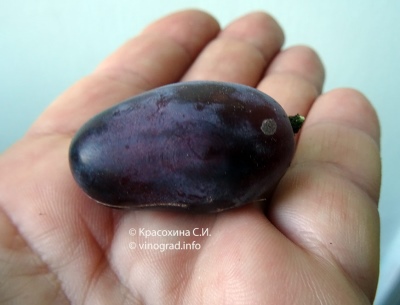
- Authors: Pavlovsky Evgeny Georgievich
- Appointment: dining room
- Berry color: lilac
- Taste: harmonious
- Ripening period: mid-late
- Ripening period, days: 130-140
- Frost resistance, ° C: -23
- Bunch weight, g: 500-1000
- Flower type: bisexual
- Peeling: No
Romeo is a fairly new grape variety. It is characterized by exquisite taste and aroma.
Breeding history
For the first time this variety was described in his book "New Hybrid Forms of Grapes" by Evgeny Georgievich Pavlovsky - winegrower, in the past a miner. It happened in 2010. Romeo is bred from two species like Demeter and Nistru. It belongs to the table grape varieties.
Description
Romeo is a tall bush. Mature shoots are brown. The foliage is dark green in color. The foliage has a rounded shape, there is an average dissection.
This variety cannot be grown for sale, but has a very refined taste and high yield. For this, he is appreciated by gardeners around the world.
Ripening period
According to the filter, it is considered a mid-late grape variety. Usually, the full ripening period is 130-140 days from the appearance of the ovary to the maturity of the crop. Ripening time - late August or early September. Bunches cannot be collected earlier than the term, otherwise they will all crack and deteriorate.
Bunches
The bunch of the Romeo variety of moderate density, conical shape, weighs from 500 to 1000 g. It has no tendency to pea.
Winegrowers believe that there is no need to prevent the berries from falling from the bunch to some extent, since this is self-improvement of the form of the species.
Berries
Romeo fruits can be lilac to dark purple in color. They are rather large and oblong in shape. The weight of one berry is about 12-18 g. Each contains 2-3 seeds.
Taste
Quite harmonious, reminiscent of marmalade. Not very sweet, as fruits contain only 17-18% sugar
Yield
Possesses high productivity: up to 1000 g of berry weight from one bunch.


Growing features
Can be planted both in spring and autumn. When buying this type of plant, you need to pay attention to the root system. Roots should be 3-4, strong and thick enough. And the shoots themselves should be at least 17 cm in length and have a dark green color.
Landing
Romeo does not like very wet soil. Planting in fertile soil is required while maintaining the distance between seedlings at least 3 m. The holes should be 80x80x80cm in size. Close contact of groundwater is prohibited.

Pollination
Does not require additional pollination, it can self-pollinate due to the presence of flowers of both sexes. The ovary is very large and has a light green color.
Pruning
Pruning is an important step in grooming. In time, it should take place at the beginning of spring. The load on the bush is normally 35 eyes.

Watering
Watering should be moderate. This variety does not like very wet soil. Ideally, watered when planting, then when pruning the vines, during flowering and already when picking berries. Use no more than 27 liters of water per 1m2.


Top dressing
To obtain a good harvest, the soil is flavored with ammonium nitrate before planting. During flowering, it is necessary to feed the plant with potassium and superphosphates. And also from time to time Romeo is fertilized a little with a mixture of humus and peat.
Frost resistance and the need for shelter
Romeo is considered a fairly frost-hardy species, can withstand temperatures down to -23 degrees, but this does not mean that he does not need additional shelter for the winter. When the bushes are covered with special material, they withstand severe frosts even better. To properly close the grapes for cold weather, they are laid on the ground, tied and wrapped in material.

Diseases and pests
Romeo is quite resistant to attacks of pests and diseases. On a five-point scale, it is resistant to gray rot, mildew and mildew by 3 points.
When yellow spots appear on the foliage (which is a sign of phylloxera disease), the grapes are treated with 1% Bordeaux liquid.
Special grids and nets are placed against bird attacks. And against wasps, a sweet solution is prepared to lure and destroy insects, and also find and eliminate their nests.

If a grape is exposed to any disease or insect, this always affects its appearance.
Storage
This variety is not grown for sale, as it is not subject to long-term storage and transportation. During transportation, grapes crack and deteriorate. Therefore, it is grown mainly for personal use on their plantations. You can store grapes in cool rooms or in the refrigerator.











































































